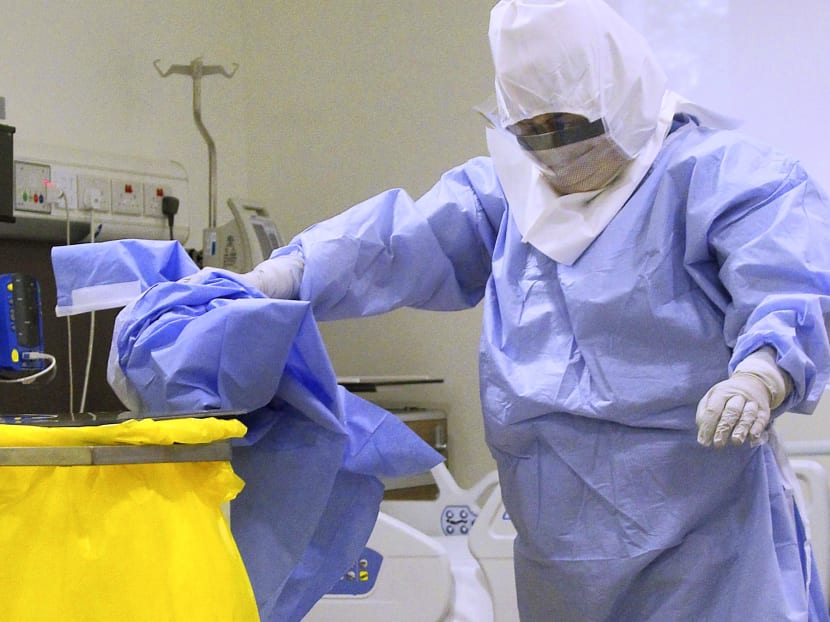Singapore steps up measures to contain any Ebola outbreak
SINGAPORE — With healthcare workers at greater risk of catching Ebola than the rest of the population here, the Ministry of Health (MOH) and Tan Tock Seng Hospital (TTSH) have stepped up training and protective measures for this group.

Senior staff nurse Naw Hser Bwe demonstrates the proper steps to taking off the Personal Protection Equipment (PPE) and disposing of it, Oct 24, 2014. Photo: Ernest Chua
SINGAPORE — With healthcare workers at greater risk of catching Ebola than the rest of the population here, the Ministry of Health (MOH) and Tan Tock Seng Hospital (TTSH) have stepped up training and protective measures for this group.
They also outlined steps taken to contain any possible outbreak: All healthcare institutions here — including hospitals, polyclinics and primary care clinics — have been advised on how to identify and isolate suspected cases.
These cases are to be promptly referred to TTSH — the hospital designated for Ebola cases — where they will be tested.
Patients will be transferred in special ambulances, while a portable medical isolation facility will be activated for transporting patients who show signs of severe illness, such as persistent vomiting.
The MOH, which last week enhanced screening measures for Ebola at Changi Airport, has also put on standby the People’s Association’s Pasir Ris chalets as possible quarantine housing in the event of a confirmed case, and will trace and quarantine all close contacts.
Speaking at a media briefing on these measures yesterday, MOH director of medical services Benjamin Ong said the spread of Ebola can be contained with early identification and isolation of patients, as well as quarantine. For example, Nigeria and Senegal have successfully prevented an imminent outbreak after they each saw one imported case of the virus, he noted.
Dr Derrick Heng, the MOH’s group director of public health, added: “This shows that containment is possible with education on good practices … In a developed country where patients get sent to hospitals early on in the course of their illness, I think the danger to the public will not be high.”
The measures come as the latest case of a New York City doctor contracting the virus — after returning from treating Ebola patients in Guinea — raised fresh fears of the spread of the disease. The case was one of several in the United States involving medical staff who cared for Ebola patients.
Compared with healthcare workers, the public has a lower risk of contracting Ebola. Said Professor Ong: “The current understanding is that Ebola requires more contact with secretions ... the very severely ill patients have lots of secretions, so caring for them as healthcare workers raises particular problems.”
In comparison, the severe acute respiratory syndrome virus — which killed 33 people here in 2003 — is mainly airborne, so the gap between risk levels for healthcare workers and the general population is smaller.
Director of the Institute of Infectious Diseases and Epidemiology at TTSH, Prof Leo Yee Sin, said a trained SWAT team had been set up to handle Ebola cases and drills had been conducted, on top of acquiring about 10,000 sets of enhanced protective gear. The team includes infectious disease experts, intensive care unit workers, nurses, housekeeping and transport staff. They have been trained and assessed to be competent in donning and removing the protective gear and have undergone drills wearing them.
The enhanced personal protective equipment — which is made of fluid-resistant material and designed to cover a person from head to toe — involves two layers of gowns and 12-inch gloves. Each worker must be checked by a colleague to ensure that the gear is in order before entering the isolation area. Full-length mirrors and step-by-step instructions have also been installed so staff can check themselves.
TTSH has also set aside two wards at its Communicable Disease Centre for isolating suspect cases. These wards comprise 13 negative-pressure isolation rooms — where air can flow into the room but not out of it — for housing suspected and confirmed cases. The hospital has also plotted a route for moving patients from the emergency department to the isolation facility quickly and with minimal contact.
To date, there has been one suspected Ebola case in Singapore, who tested negative.
The MOH said two National University Hospital staff — Dr Dale Fisher and Ms Sharon Salmon — had volunteered in Liberia, but that their work did not involve exposure to Ebola patients. “It has been more than 21 days since they returned to Singapore. They took their temperature twice a day and monitored themselves closely for symptoms … (Returning) healthcare workers with protected contact with Ebola patients — which Dr Fisher and Ms Salmon did not have — will be put under phone surveillance for 21 days,” said a ministry spokesperson.






